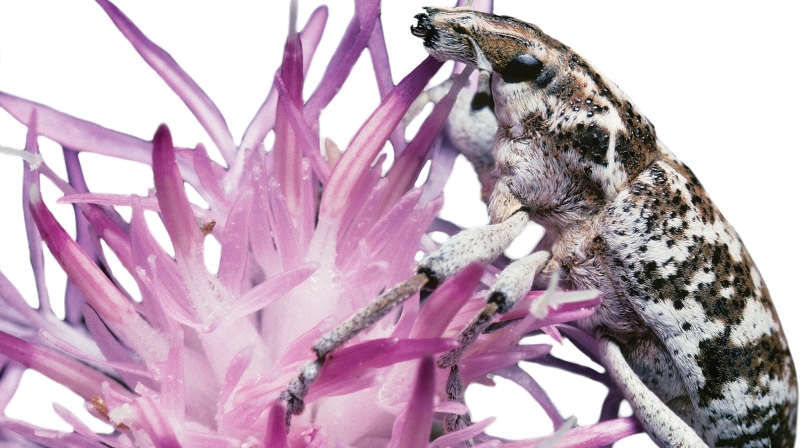The Lesser of Two Weevils: Controlling Weeds with Bugs

Problem: Keeping noxious invasive weeds out of Lincoln County, Mont.
Solution: Purchase, raise and disperse weevil bugs to eat the weeds and their seeds.
It sounds like something out of a sci-fi flick: Bugs crunching and munching their way across vast acres, destroying everything in their path. In Lincoln County, Mont., they’re a solution to a big problem: They devour noxious weeds invading the area.
And there’s a lot of area to cover. Lincoln County, situated in the northwest corner of the state bordering Canada, consists of 3,728 square miles of land (the federal government owns the majority of it). In all, the county contains 1,398 miles of county roads, 242 miles of state and federal highways with approximately 15,000 acres of right-of-way in which Lincoln County Weed District is directly responsible for noxious weed management.
Dan Williams heads up the Lincoln County weed department. Although he has several tools in his weed-killing arsenal, one of the more unusual? Bugs or more specifically knapweed seedhead weevils and knapweed root weevils. They eat noxious invasive weeds and their seeds, mainly rush skeleton weed (part of the dandelion family), tansy ragwort (it’s toxic to livestock when inadvertently cut and dried with other pasture grass for hay) and spotted knapweed (known for its deceptively pretty purple and pink flowers). If left unchecked, the weeds can crowd out vegetation for grazing livestock and wildlife.
The county was using bugs when Williams came on board the weed department 17 years ago; entomologists had done the research and Williams was a believer. “They showed me how to do it and it worked, I trusted them,” he said.
But the method the department was using at the time was what he called “a shotgun approach.” He was looking to carpet-bomb the county with the critters.
Several years went by before he was able to hatch his plan. The opportunity presented itself after he was contacted by the Forest Service about some possible funding; he wrote a grant and received $36,000. He was able to build on that amount by contacting public and private partners who also had weed problems, including the Forest Service, Plum Creek Timber, the Army Corps of Engineers, Mines Management Co. and the state Natural Resources and Conservation Department.
They all chipped money into a bug-buying pot that grew to nearly $80,000. Williams then entertained bids from four private companies that sell the bugs. They usually cost $1 apiece, but he was able to get them for 24 cents each (as well as loads of another species of free weed-eating bugs that the company, Biological Control of Weeds, Inc., didn’t want to take the time to pick out of the bunch).
“We bought a lot of bugs,” Williams said. The bugs arrived in 4-inch cups, 200 to 500 per cup, packed inside 3-foot by 3-foot boxes.
Now Williams had an army of bugs to disperse every quarter mile where needed (they’re flung into weed-infested areas), and his partners came and picked up their bugs and did the same. On top of that, with the bugs reproducing, the county saves money because they don’t have to purchase any more (except when Williams is experimenting with different types of bugs for different types of weeds). Williams estimates Lincoln County now has about a billion weevils all chomping away on weeds across the county.
The weed-eating bugs come in especially handy in areas where spraying is not an option, such as steep hills or river banks that are inaccessible to equipment, Williams noted.
The bugs also provide an educational experience for students at the county’s Eureka High School, who raise and collect a bunch of them on 20 acres of land (that also includes weeds) owned by the Montana Department of Transportation, which pays the students for their work. The general public is also invited to come out and collect some of the bugs if they have a weed problem that needs help.
“Bio-control is an important part of weed control,” Williams said. “Some people don’t think bugs are going to help but this does work and it does help.”
Attachments
Related News

Counties directly eligible for $5.2 billion in competitive transportation grants
Counties are directly eligible for $5.2 billion in competitive transportation grants.

Join NACo in celebrating County Health Day on April 19, 2024
Please join NACo in celebrating County Health Day on Friday, April 19!

